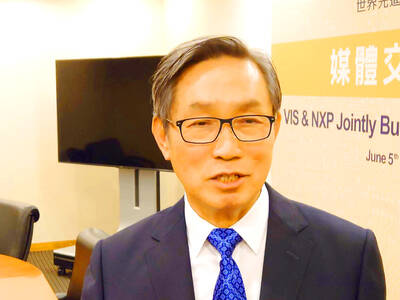Gigabyte Technology Co Ltd (技嘉), a leading supplier of motherboards and graphics cards, is forecast to see lower profitability in the second quarter, due to a decline in shipments and graphics cards prices as the cryptocurrency mining frenzy gradually abates, Capital Investment Management Corp (群益投顧) said last week.
Cryptocurrency mining continues to suffer from tighter security and regulatory measures around the world, with bitcoin’s price having dropped about 55 percent this year, Bloomberg News said, citing the Luxembourg-based Bitstamp exchange.
“The prices of major cryptocurrencies have plunged after peaking in early 2018 ... leading to persistently lower demand for cryptocurrency mining and for Gigabyte graphics card shipments, which decreased somewhat since the beginning of the second quarter,” Capital Investment said in a note on Thursday last week.
Gigabyte’s revenues reached about NT$5 billion (US$163.9 million) in April and again in May, notably lower than March’s NT$8.5 billion, and its second-quarter revenues could be less than in the first quarter, Capital Investment said.
“In our opinion, as the average selling price of graphics cards is expected to edge down, the second-quarter gross margin could underperform quarter-on-quarter,” the investment advisory firm said.
Gigabyte shipped 1.2 million graphics cards in the first quarter and the company said that shipments could see a quarterly decline of 20 percent in the second quarter, the Chinese-language Economic Daily News reported on Wednesday.
The company shipped between 300,000 and 350,000 graphics card units in April and again in May, compared with 450,000 in March, the report said.
Sales from motherboards accounted for 49 percent of Gigabyte’s total sales in the first quarter, followed by graphics cards at 36 percent and servers at 15 percent, the newspaper quoted company spokesman K.J. Sun (孫國仁) as saying at an investors’ conference.
The proportion of sales from graphics cards would drop quarterly in the second quarter, while sales from motherboards and servers would increase, Sun said, without elaborating.
In the second half this year, the company is expecting Nvidia Corp’s planned launch of its new family of Volta graphics processing units (GPUs) to bolster graphics card sales, he said.
However, demand for graphics cards in the next few quarters might not be as robust as the company expects, despite the rapid development of the e-sports industry, Capital Investment said.
It is rumored that Nvidia’s inventory of old GPUs remains high and the launch of the new GPU model might be postponed until September or even the fourth quarter, while Intel Corp might also delay the launch of its new Cannon Lake chip, Capital Investment said.
“Gigabyte’s revenue and earnings in the second half this year could be negatively affected,” it said.
Gigabyte shares on Friday rose 3.22 percent to NT$67.4 in Taipei trading. It reported that its sales for the first five months of the year rose 40.34 percent year-on-year to NT$30.53 billion.
The company saw its shares fall 14.25 percent last month, mirroring broad-based declines among local motherboard and graphics card makers in light of the weaker demand for products used in cryptocurrency mining and the delayed launch of Nvidia’s Volta GPU.

TARIFFS: The global ‘panic atmosphere remains strong,’ and foreign investors have continued to sell their holdings since the start of the year, the Ministry of Finance said The government yesterday authorized the activation of its NT$500 billion (US$15.15 billion) National Stabilization Fund (NSF) to prop up the local stock market after two days of sharp falls in reaction to US President Donald Trump’s new import tariffs. The Ministry of Finance said in a statement after the market close that the steering committee of the fund had been given the go-ahead to intervene in the market to bolster Taiwanese shares in a time of crisis. The fund has been authorized to use its assets “to carry out market stabilization tasks as appropriate to maintain the stability of Taiwan’s

STEEP DECLINE: Yesterday’s drop was the third-steepest in its history, the steepest being Monday’s drop in the wake of the tariff announcement on Wednesday last week Taiwanese stocks continued their heavy sell-off yesterday, as concerns over US tariffs and unwinding of leveraged bets weighed on the market. The benchmark TAIEX plunged 1,068.19 points, or 5.79 percent, to 17,391.76, notching the biggest drop among Asian peers as it hit a 15-month low. The decline came even after the government on late Tuesday authorized the NT$500 billion (US$15.2 billion) National Stabilization Fund (國安基金) to step in to buoy the market amid investors’ worries over tariffs imposed by US President Donald Trump. Yesterday’s decline was the third-steepest in its history, trailing only the declines of 2,065.87 points on Monday and

TARIFF CONCERNS: The chipmaker cited global uncertainty from US tariffs and a weakening economic outlook, but said its Singapore expansion remains on track Vanguard International Semiconductor Corp (世界先進), a foundry service provider specializing in producing power management and display driver chips, yesterday withdrew its full-year revenue projection of moderate growth for this year, as escalating US tariff tensions raised uncertainty and concern about a potential economic recession. The Hsinchu-based chipmaker in February said revenues this year would grow mildly from last year based on improving supply chain inventory levels and market demand. At the time, it also anticipated gradual quarter revenue growth. However, the US’ sweeping tariff policy has upended the industry’s supply chains and weakened economic prospects for the world economy, it said. “Now

An employment discrimination lawsuit against contract chipmaker Taiwan Semiconductor Manufacturing Co (TSMC, 台積電) might soon be expanded after a hearing in a federal court in San Jose, California, on Tuesday to add 15 plaintiffs to the case. According to a court document, the lawsuit, which was refiled in November last year as a form of a class action with 13 plaintiffs in California, wants to add 15 plaintiffs from Arizona, where TSMC is building up its wafer fab capacity. TSMC first committed between 2020 and last year to invest US$65 billion in three advanced wafer fabs in Arizona. It then pledged an